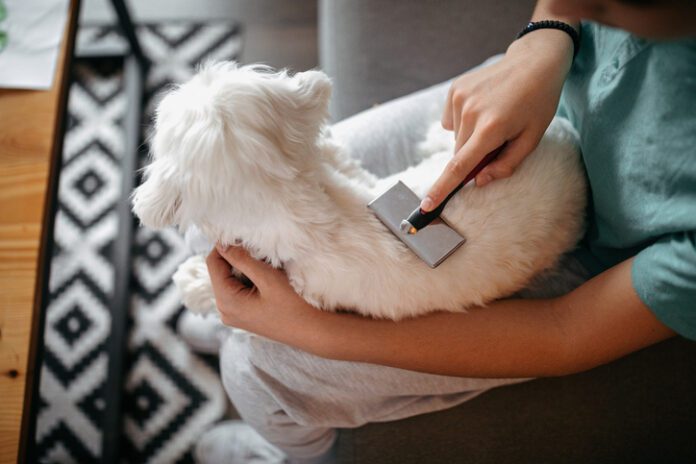
So, your dog’s not a fan of your at-home spa day, but his coat requires regular brushing, and you want to keep his nails manageable for his own comfort. What can you do? Here are five tips to help make grooming a bit more pleasant for all involved:
Practice all the parts of a grooming session, without the grooming
Decide how you’ll both be most comfortable during grooming and practice this set-up without performing any grooming. Maybe it’s with your dog atop a grooming table or maybe it’s with your dog in your lap. Whatever the set-up, make sure your dog can access it on his own, so he has a choice to participate or not – but treats only happen during participation. (We all value the freedom to choose!) Practice the set-up without grooming daily to help build and maintain a positive association with the situation. Otherwise, your dog will see your set-up and immediately think, “Uh oh!”
Use high-value rewards
If I’m performing a task I find unpleasant, but my boss is providing a nice bonus for my participation, I still don’t love the task at hand, but I have a reason to feel a bit better about it. The same goes with our dogs. Don’t be afraid to pay generously and use your dog’s favorite treats while grooming. If you have a helper, they can feed treats as you groom. If you’re working alone, try stuffing high-value food into a Toppl or Kong, or blend it up and smear it onto a lick mat to keep your dog busy while you work. If your dog isn’t food motivated but is obsessed with a favorite toy, use that instead.
Try grooming a tired dog
For some dogs, it’s easier to tolerate grooming when they’re tired and content after a long day of enriching activity. Go out for a long walk in a new area and give your dog plenty of time to sniff his way around and take in all the new olfactory information. If the area is appropriate, you can even use a long line in place of your regular short leash to simulate some off-leash time where your dog can really enjoy the sights, sounds – and smells! Or schedule a play date with appropriate dog friends. Some dogs find it easier to go with the flow and accept light grooming when they’re tired. Other dogs might be edgy and irritable if disturbed when tired, so be aware of your dog’s body language and respect what she’s telling you.
Break it down
Accept that you may not be able to groom the entire dog in one sitting. If your dog struggles with grooming, try making sessions much shorter and end the session before it’s turned into a prolonged struggle and do a little more tomorrow. You’ll both be happier!
Be patient, respect your dog and train for the behavior you want
If your dog isn’t a fan of grooming, find a positive reinforcement trainer who can help you create a training program that’s right for your dog. Whether the issue is trimming nails or cooperating on the grooming table for a thorough brushing, a thoughtful training program can help improve the situation for both species! Just like humans, all dogs are different and what technique might work quickly for one dog can take longer – or need adjustment – with another. While it can be tempting to use force and “strong arm” a dog into compliance via restraint in order to get the job done this time, in the long run, that will make the issue worse. Taking the time to make grooming enjoyable for your dog – or least something they willingly tolerate – will benefit you and your dog for years to come.




